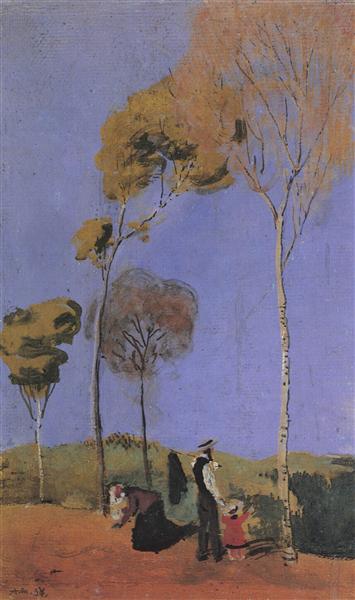Description
August Macke, one of the most prominent representatives of German expressionism, captures in his "stroller" painting of 1907 an intimate and vibrant scene that reflects both his interest in everyday life and his mastery in the use of color. This work is an eloquent example of the artist's approach to reality, where the representation of the human figure and the environment merged into a visual symphony that invites contemplation.
He painting It shows a woman behind a childhood stroller, an image that may seem simple at first sight, but that rises to a new dimension through the palette and composition. Macke uses a range of bright and saturated colors that provide the scene with an almost palpable energy. The yellow, blue and roses tones are intertwined and complemented, creating a bright and cheerful atmosphere. This chromatic choice not only gives life to the characters, but also suggests an emotional state that evokes the happiness and warmth of the family home.
As for the composition, Macke establishes a dynamic balance between the figure of the woman, the stroller and the environment. The angle in which the woman is presented, somewhat framed so that her position is crucial for the visual message, suggests both protection and dedication. The vertical format of the stroller contrasts with the horizontality of the environment, creating a visual tension that attracts the viewer's gaze towards the center of the work.
The characters that inhabit this scene, although limited to the woman and her stroller, symbolize a broader universe. The female figure, carrying a high -wing hat that could be interpreted as a fashion symbol of the time, is presented with a serenity that can offer a reflection on the role of women in the society of the early twentieth century. Macke, in its historical context, is contemporary of significant social and cultural changes, and although in this work it seems to capture everyday life, there is a background of deep transformations that are brewing.
This work can be contextualized in the broader production of Macke, who often sought to explore the intersection between modernity and everyday life. The simplicity of "stroller" is intertwined with the search for the artist for capturing moments of joy in a world that was beginning to face the tragedies of war and disenchantment. The works of other expressionist artists, such as Ernst Ludwig Kirchner, share this approach to the human figure, but Macke offers a brighter and more optimistic vision, often marked by the innocence and joy of family moments.
In addition, it is relevant to mention that Makce was influenced by the works of Henri Matisse and the Fauvistas, who promoted the use of color as a vehicle for emotional expression. In "stroller", this influence is evidenced in the way in which colors not only illustrate reality, but also transform the spectator's perception, leading it to an almost sensory experience.
The work, although simple in its theme, is rich in cultural and emotional connotations, reflecting not only Macke's personal vision, but also the spirit of an era in transformation. "Cochecito" thus becomes a testimony of the constant search for art to capture the essence of life itself, and in Macke's work, this essence shines with particular intensity.
KUADROS ©, a famous paint on your wall.
Hand-made oil painting reproductions, with the quality of professional artists and the distinctive seal of KUADROS ©.
Art reproduction service with satisfaction guarantee. If you are not completely satisfied with the replica of your painting, we refund your money 100%.

